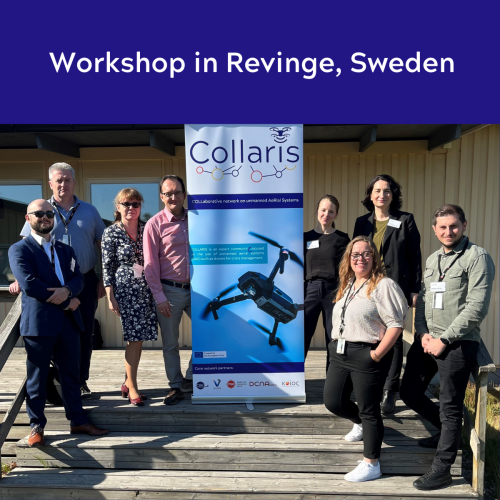Approximately 20 public stakeholders from several Member States were welcomed to the MSB Revinge College (Sweden) on May 30 to interact in discussions on current and upcoming perspectives on UAS and Air Traffic Management (ATM) for crisis management and first response. Invited speakers presented different perspectives on opportunities and challenges while an open session also offered participants to make presentations.
The workshop was an excellent opportunity to exchange knowledge, share practical experiences and discuss different issues related to:
- Current and future challenges in Air Traffic Management during emergencies,
- National and regional „use cases” of operational deployment of drones for different cisis management purposes from Sweden, Denmark, France and Poland (including personnel training aspects),
- Benefits and risks of artificial intelligence (AI) and UAS for disaster management,
- Available auxiliary support systems, apart from simple cameras,
- Cyber security issues relevant to the efficient use of UAS,
- Copernicus drone mapping operations for Copernicus Emergency Management Service,
- Collaris Network scope of activities and plans for the future, including upcoming field and training trials.
There is no doubt that currently Air Traffic Management solutions are the key enabler for drone operations in crisis management. We have to be able to fly safely before we think about other issues like data analysis and sharing, using Artificial Intelligence, addressing cyber security issues or privacy and personal data protection concerns. This was the recurring theme of most presentations and interventions during the workshop. Thus, the ATM system for crisis management under development in Poland will be the main topic of the first COLLARIS field trial in late August.
The short-term challenges we are now facing are related to ensuring the safety of flights during crisis operations (with use of multiple UAVs [unmanned aerial vehicles] and with use of UAVs parallel to human-operated aviation).
More detailed issues related to these and other problems as well as benefits of operational use of drones were presented from different perspectives at regional levels (two cases from Sweden: Västra Götaland County and Research Institutes of Sweden, RISE) and national levels (Swedish Police, Danish Emergency Management Agency, Crisis Information Centre from Poland and Entente Valabre from France).
Västra Götaland County is currently focused on using drones to deliver defibrillators to save lives, but in the future would like to follow examples from the US to have drones be “first at scene” to get situational awareness, monitor traffic, help handle detection of fires, drowning situations etc. RISE is developing and testing various use cases of UAS with new technologies (for instance how to use Lidar and nRTK for measuring the height of trees, their crown width and ground conditions).
Today’s solutions and the challenges of tomorrow
Swedish Police underlined that every organisation has identified the same current challenges: all weather operations, air space availability, mixed manned / unmanned operations, air time, BVLOS regulations, Artificial Intelligence ), technology development, but also “the new technologies dilemma” covering the issues of control (automatic vs. autonomous), effect and responsibility.
The background of the Polish ”Search and Help” ATM system (currently under development) was presented, as well as its basic components (IT system, procedures, personnel), planned key functionalities and lessons learnt from already conducted activities. Last but not least, a brief overview of the current training activities in France was given, copmlemented with a potential vision of UAV European training of the future.
Three horizontal and “cross-cutting” issues related to the use of drones were also addressed during the workshop: auxiliary support systems, Artificial Intelligence and cyber security.
Disaster Competence Network Austria (DCNA) pointed out that most studies on auxiliary support systems like sensors focus on the use of cameras and situation pictures only and therefore COLLARIS will also include other forms of auxiliary support systems. Furthermore, UAS use comes with many challenges such as data protection concerns, trust issues, costs of logistics and staff.
KIOS underlined that AI) and UAS play critical roles in disaster management and response. These technologies can significantly improve the effectiveness, efficiency, and safety of disaster relief efforts.
MSB emphasized that all kinds of IT systems are vulnerable and prone to be attacked, including those on board of drones and satellites. Therefore, information security protection is necessary regardless of these systems being on ground, in air or in space. There are different challenges in implementing UAS, going beyond “just” technical and organizational issues such as social and legal (GDPR) aspects but also overarching challenges such as robustness and supply chains that need to be catered for.
Open Session Presentations
Finally, an international point of view was offered by speakers from the Copernicus (European Earth observation programme) drone mapping operation service and the International Emergency Drone Organization. The first presented a slightly less known “face” of the Copernicus Emergency Management Service: drone mapping - aiming to establish an EU-wide drone operators’ network, with a dedicated GIS-Tool for quick deployment, able to collect drone data after activation and provide processed data within 48 hours. The second one shared experiences of a worldwide non-profit association of drone pilots among first responders (firefighters, police, paramedics, doctors, SAR volunteers, coast guards etc. – individual persons, no companies to preserve neutrality).
Find the full workshop report on the COLLARIS project website.

